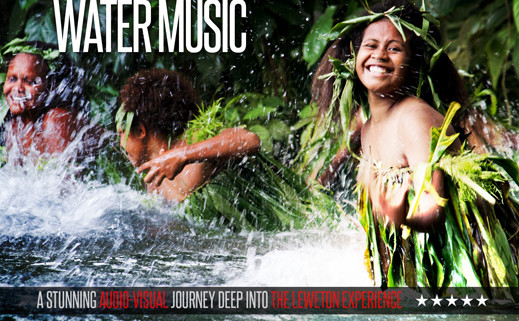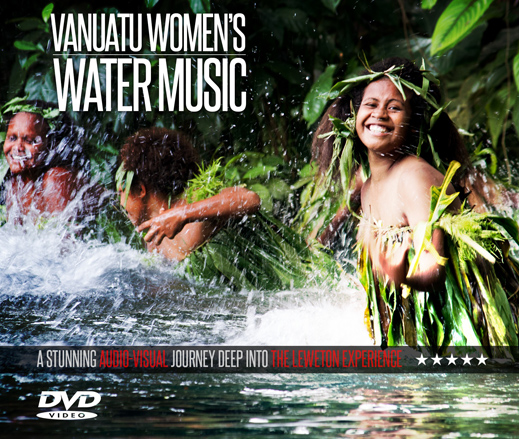Vanuatu Women’s Water Music
A special feature of SCANZ2015:water*peace is the Aotearoa New Zealand launch of the Vanuatu Women’s Water Music DVD. The Water Music dance involves the performers standing waste deep in the water, and slapping the surface as part of the dance. This is performed by the Leweton Cultural Experience. They are based on the remote northern islands of Gaua and Merelava in Vanuatu, and live in a village in Espiritu Santo where they present, share and maintain their unique cultural traditions and practises across cultures and generations.
Wantok Musik and Intercreate.org in association with Te Matahiapo Indigenous Research Organisation, Creative New Zealand, TSB Community Trust, the Western Institute of Technology at Taranaki and the Intercreate.org community are honoured to host two members of the Leweton Cultural Experience, Sandy Sur and Prim Rose Wari who will attend SCANZ2015:water*peace, and take part in the International Celebrations of Water and Peace from Friday January 30th to February 1st in central Nga Motu New Plymouth, based around the Huatoki stream walkway and plazas. The SCANZ residency begins on the 17th of January with many projects presented on the celebration weekend.
Following is an account of the development of the water dance.
The History of the Magical Water Music
My name is Warren Wevat Wessergo. I come from a village called Dolap in West Gaua.
All of the women from the Banks Islands, in the north of Vanuatu, can make music by splashing the water. This is very common. But this is just a standard sound all over the islands. However, in 1974, my aunt, Elizabeth Womal Marego, with her daughters, and my mother, Zalet (Charlotte) Hilda, with my sisters, they all came together to discuss the development of the ‘sound of splashing water’ into something more like ‘water music’.
The reason that these women decided to explore the idea of developing the ‘water music’ was that they had noticed the people on yachts displayed an increasing interest in the practice. Indeed, one of these yachtspeople had given a “Visitors Register” book to a Catechist on the island by the name of Patteson Worere. Patteson kept the book in the church and all the visiting yachts to Dulap were asked to nominate someone to enter the name of the yacht and their signature into the Visitors Register.
After all the discussions, Elizabeth, Zalet and their daughters chose Rovan Womal Marego to be the first leader of the Water Music group. Rovan worked with the women to codify and name the various sounds, beats, rhythms and chords of the water music. This is important because no one had ever given a name to the sounds of the splashing water before. Before they could create new sounds, they need to name the existing sound. So Elizabeth and Zalet decided that the first task for Rovan was to lead the group through the process of naming the existing sound from splashing water – the sound that was practiced all over the Banks Islands. They named this vus tuwal.
Then they named the four other ‘beats’ that they had just created:
kor nē-bē – the sound of rainwater falling over stones
ne kia – the sound of dolphins flapping their fins on the water
nē-rē – the sound of rainwater falling on leaves and thatched roof
vus ero – the sound of people chasing and shepherding fish into traps and nets
Elizabeth and Zalet and their daughters spent the rest of the year practicing the newly created beats and rhythms close to my house in the water at Lembrig Spring. Then in 1975, some more yachts visited West Gaua asking to hear the Water Music. My sister Martha Rowon was practising the new Water Music at the seashore. Some yachts in the area could hear the sounds that she was making. Intruiged by the strange tonal qualities of the music, the yachts searched for the source of the sounds. Eventually they found Martha on the reef and some of them were so impressed with the music that they presented Martha with gifts of clothes, shoes, and jewelry. This was the first instance of someone attracting visitors especially to see and hear the Water Music.
In August 1975, another yacht visited the area. These visitors also brought with them a camera. Many of the villagers were excited by the camera and the opportunity to have their photo taken. In all the excitement, a small boy was washed off the reef by a large wave while his parents were distracted by the camera. Eventually his drowned body was found and brought ashore. The local pastor at the time was a cousin of Martha. His name was Father Marcel Wewot. Father Marcel prayed for the boy to bring him back to life. Miraculouly, he was successful so he baptized him Wewot Lembrig. So now, every year during yachting season, the daughters of Elizabeth and Zalet, and the daughters of their daughters, they go down to the reef at Lambrig Spring and entertain the visitors with the magical water music. At the end of their show, the owners of the yachts hand over bags of second hand clothes, shoes, and other gifts and everyone remembers the miracle of Wewot Lembrig.
Time went by without much significant change. [There was plenty of migration of people from Gaua and neighbouring Merelava to (and from) Luganville, on the island of Espiritu Santo.] Tourists would come on yachts during the dry season and the women would perform the water music in exchange for some gifts. Then in the year 2000, Mr Sandy Sur brought some tourists to Dulap on a cruising yacht. But this time, the tourists were so impressed that when Sandy suggested that the tourists pay the women with cash, the tourists were happy to oblige. And so this occasion marked the transition from an amateur folkloric performance into a professional, revenue-raising, tourist attraction. The word passed around amongst the other yachties and tourists that there was a magical water music performance to be seen in Dulap and so many other tour companies and independent yachties started to come to Gaua. And so this occasion marked the transition from an amateur folkloric performance into a professional, revenue-raising, tourist attraction. We had begun the process of commercialising the water music.
A few years later in 2003, the Provincial government of TORBA held an Arts Festival in the village of Aver at North Gaua. The women from Dulap made their way to Aver for the Arts Festival and for the first time, performed the new water music for the Vanuatu public (as opposed to tourists). The people of North Gaua and the other visitors were amazed at this new water music. There were two English volunteers teaching at Losalava school at the time and they helped the news of the new water music performance reach the community in Port Vila. This was the first time that Tom Dick from Further Arts had heard of the water music, but his ethnomusicologist friend Monika Stern, had recorded the water music in Merelava some years before. Tom and Monika presented the idea of the water music to the Head of the Delegation of the European Union, Nicolas Berlanga Martinez. Nicolas was also very impressed with the water music and he arranged for some of the family members to travel to Zaragoza in Spain for the World Expo of 2004.
Then Sandy Sur organized a meeting of the Mwerlap-speaking diaspora of people from Gaua and Merelava who were living on a block of land in the Sograon (Showground) area just on the fringes of Luganville – the “northern town” as it is known by residents of the capital, Port Vila, in the south – or “Canal” as it is known by locals of the island of Espiritu Santo. By this time, many of the original innovators of the water music from 1974 were living in Luganville. Through this meeting Sandy galvanized the family around the performance of “water music”. Sandy knew the potential of the cultural practice of the water music as a tourist spectacle.
During the course of the meeting several different activities were suggested as being able to be presented as a package to tourists. These activities included traditional dance (terrestrial) of men and women respectively – and a communal dance featuring the whole community. Warren was adamant that the water music had to be a feature of the package of activities that were presented to the tourists. It was important that this will of Warren be clear to all as it is Warren’s mother and Aunt and sister who were the original innovators of the water music in 1974 in the nasara of Wevat Wessergro, Saint Bartholomew, West Gaua. To this end, the meeting continued long into the night, and also moved down to the shore where the men and women could stand in the water and visualize the water music, and test and demonstrate the possibility of its transmission. In the end, Hilda Rosal Wavales Warren, Warren’s wife, was appointed to the role of Maestra (Creator, Composer and Teacher) of Water Music for the Leweton community.
Hilda worked very hard to develop the water music and to engage all the women and girls in the community. It is largely due to her hard work that we can say that the Leweton Cultural Group has become so popular and that the Vanuatu Women’s Water Music is known around the world. Hilda created eight more water music chords which are totally different to the original sounds and the other five beats listed above, and each of the eight new ones have their own names and meanings. These names and meanings were developed through a collaborative process involving the full community going to the ocean’s edge to listen to the women performing the sounds and the community would listen to the music and share their thoughts and feelings as to the meaning and names of the sounds. Chief Colin, Kuber, Judah, Sandy Sur, and other chiefs and community leaders were there. All the participants had a pen and paper and they wrote down their ideas for the names and meanings of the songs: sometimes the meaning of the song was attributed to the ocean, other times to the sky or the land. All of the names and meanings were assigned in the Mwerlap language which is the language of Merelava and East Gaua, and each of them are a product of Leweton.
This information has been presented by Warren Wevat Wessergo from West Gaua. This is his story. Additional information has been compiled by Sandy Sur and Thomas Dick. Translated from bislama by Thomas Dick.


